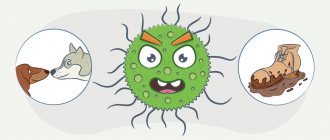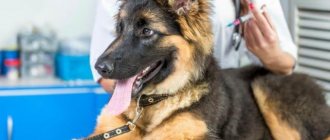Growth of dachshund puppies at different periods of life. Rules for caring for them and preparing for purchase. First vaccinations and their timing. Where and for how much can you buy a dachshund puppy.
The history of dachshunds began in Germany. In this country, hunting foxes and other wild animals has always been a popular and affordable sport . To perfect the process, existing hounds were selected for specific parameters for burrow work.
Short-legged dogs were used in breeding dachshunds. As a result of this selection, individuals with an elongated body and short legs appeared.
Mutations have made dachshunds a unique breed. Their hunting qualities were appreciated not only in their homeland. Soon these dogs came to England and earned the respect of local dog lovers and gambling enthusiasts. Dachshunds lived in the houses of noble families; aristocrats especially liked long-haired dogs.
They were shown as a sign of wealth. Ladies of high society were fascinated by the beauty of dachshunds with long and shiny hair.
These dogs owe their existence to enthusiasts who crossed smooth-haired individuals with spaniels. A little later, work on breeding wire-haired dogs was crowned with success. For a long time, interbreed matings with schnauzers and terriers did not produce positive results.
Only at the end of the 19th century did wire-haired dachshunds become an independent and full-fledged variety of the breed. They have differences from their smooth-haired ancestors, but in general they are wonderful hunters and loyal friends of humans.
Currently, dachshunds serve as companions for their owners. There are hunting fans among breeders and owners. Dogs are poisoned at special stations, and they are also allowed into a fox or rabbit hole in natural conditions.
Selecting a dachshund by size
The easiest way to distinguish is the standard type. These puppies are large, with strong bones and a large chest girth.
They always look at the parents first. Standard ones have a better chance of producing offspring of similar size.
Miniature dachshunds give birth to "rabbits" and "dwarfs", but there are exceptions if a large dog has the corresponding gene.
There is little difference in small dogs. Rabbit and miniature dachshunds grow at about the same rate. By 8-9 months it will become clear what type the puppy is.
They are often identified as rabbits, but the difference in chest circumference with dwarfs is up to 1 cm. To avoid confusion, official measurements are taken upon reaching 15 months.
Documentation of vaccination
If your pet will participate in exhibitions, or you will simply take it abroad, you will need an international veterinary dog passport. It lists all the vaccinations your dog has received.
Also, when traveling abroad, you may need to prepare additional documents for transportation (issued in state veterinary clinics). In EU countries, a dog, among other things, will need to have an implanted electronic chip, that is, the dog will need to be microchipped.
Our clinic is certified according to international standards and provides, among other things, microchipping services. This simple procedure is painless and harmless for the animal. The chip is the size of a grain of rice and is implanted under the skin in the withers area. It allows you to read information about your pet and the owner. The information is read after entering a unique code (15 characters) into the database.
Puppies after birth
Newborn dachshunds have weak and elastic ligaments and muscles. This is necessary so that they are less injured. The eyes are still closed, the ears are pressed very tightly to the head. They feed on mother's milk, and in the first days on fatty colostrum. They squeak and fidget from time to time, but once they are full and warm, they quickly calm down.
From the 10th day, the puppies' eyes open and their hearing becomes more acute. The color of the iris is usually blue and slightly cloudy. Small dachshunds are already moving more, their activity is growing every day, as is their body weight.
By 14 days they try to interact with each other. Clumsy attempts at play and biting are necessary for primary skills and reflexes. Clutching his littermate's ear with his weak jaws, the puppy understands how much force is needed to hurt.
Post-vaccination reactions
Post-vaccination reactions are a normal reaction of the body to the introduction of a vaccine. All of them are characterized by a short duration (usually 1-2 days, up to a maximum of 5), go away on their own without external intervention and, most importantly, do not cause any negative consequences for the body of the vaccinated person.
Specific reactions largely depend on the type of vaccine (for live vaccines they can be similar to symptoms of the disease), and they are usually divided into local and general.
Local reactions
These are reactions localized at the site of vaccine administration. The most typical:
- Redness and induration, swelling, hardening of lymph nodes
- Painful sensations
- Allergic rash
These are typical reactions to damage to the skin during an injection and the appearance of “strangers” in the body. But you need to be careful: if, for example, redness is more than 8 cm and swelling is more than 5 cm, you should consult a doctor. Painful sensations should go away within 1-3 days; if the pain is severe or interferes with sleep, you can give an anesthetic.
With repeated vaccination, local reactions occur more often: for example, for DTP - up to 50%, pneumococcal - up to 20%, for other vaccinations - from 5 to 15%. Of the live vaccines, local reactions are most often observed for BCG (for tuberculosis).
Sometimes vaccines are specially formulated to cause local reactions, which increases the body's immune response. For such vaccines (DTP, ADS, hepatitis A, B), local reactions are natural and should not cause concern.
Local reactions and their intensity are also influenced by the method of vaccine administration: it is better to do it intramuscularly, since the muscles are well supplied with blood - as a result, the vaccine is absorbed faster and the effectiveness of the vaccine increases.
You can find out more about local reactions in a separate article.
General reactions
Reactions that affect the body as a whole, but pass quickly and do not cause subsequent complications. The most typical of them:
- The most well-known is an increase in temperature: if it does not exceed 38-38.5 degrees and goes away within 2-3 days, there is nothing to worry about.
- General lethargy, discomfort, feeling of malaise, headache, dizziness, anxiety can last 2-3 days and are mild and do not interfere with usual activity.
- Sometimes there are short-term problems with sleep and even loss of appetite.
- Some components of vaccines can rarely cause allergic reactions, which manifest themselves as a rash.
- When using live vaccines, you may experience mild symptoms of the disease being vaccinated against: this is a normal reaction for this type of vaccine.
Normal reactions
Here are normal reactions to some vaccines, including those included in the national vaccination calendar:
- DTP - the injection site may hurt and there may be slight swelling, a short-term increase in temperature to subfebrile and even febrile levels for up to 3 days.
- BCG is a papule at the injection site that erodes and a scar remains in its place.
- Hepatitis B – possible pain at the injection site for no more than 3 days.
- OPV – without general reactions.
- Measles is a low-grade fever that may appear on days 7-12; it lasts no more than 3 days and does not require antipyretic medications. Measles rash is extremely rare.
- Rubella - after 6-14 days, cold symptoms may appear: low fever, sore throat, runny nose, but all this quickly passes without outside intervention.
- Mumps - pain at the injection site, a slight increase in temperature and mild malaise for 5-15 days.
- Chicken pox – within 3 weeks a small number of elements of chickenpox rash may appear, and a slight increase in temperature.
- Rotavirus infection - fever, vomiting and diarrhea, which quickly disappear.
- COVID-19 in most cases is mild or moderate in nature and is short-lived: fever, weakness, headache. muscle pain, chills, diarrhea, pain at the injection site. The likelihood of experiencing any of these side effects varies depending on the vaccine.
More severe and prolonged reactions are possible but are extremely rare. In addition, vaccines are constantly undergoing new tests. This is done to identify rare side effects.
The given list of possible side effects in no way claims to be complete or absolute truth: we just want to reassure parents whose children have been vaccinated.
Frequency of adverse reactions
The consequences of using known vaccines have been well studied, including the frequency of adverse reactions: they occur in no more than 10% of vaccinated people, and in 95% of cases the symptoms are so minor that they do not require visiting a doctor. The vaccine against rubella causes general reactions on average in 5% of cases, and against hepatitis B – 7% of local reactions.
As for possible complications, they occur much less frequently than adverse reactions: for most vaccines - 1 case per million or more vaccinations, and severe ones - even less often.
Timing of reactions
Adverse reactions to inactive vaccines usually appear early (within a few hours), but they are mild and pass quickly.
As a rule, side effects of vaccines appear within 4 weeks, and only after BCG side effects can be observed even after 14 weeks.
Reactions to a live measles vaccine cannot appear earlier than 4 days and later than 12-14 days, for polio and mumps vaccines - 30 days.
1-2 months
The puppy learns to interact with the outside world. Games take more time, because communication with relatives helps to put together a picture of the world. Exploring new places attracts puppies and brings them a lot of emotions.
Important: Now it is too early to separate the puppies from their mother, although she practically does not feed them. She shows how to behave in a pack and teaches useful things.
Now the puppies are very receptive to training. They form their first habits. The breeder must formulate the correct behavior very carefully, limiting access or reinforcing a positive result.
Development
Standard dachshund cubs grow quickly and get stronger. 2 weeks after birth, dogs can already suck from a bottle and behave calmly when they are picked up. They are even capable of growling at the offender from among their brothers and sisters.
Between the second and third week, babies develop hearing. This is the time when they begin to eat solid food, stand confidently on their paws, and play. At the fourth week, dogs erupt their first teeth - the upper canines. Month-old dachshund puppies are curious and eager to explore the world. They are no longer afraid to leave their mother, they explore the territory, and try to chew on objects.
Six-month-old puppies become similar to adult dogs. At this stage, the dachshund may try to become the master of the house. But you shouldn’t allow your dog too much. Mistakes made by the owner can lead to problems with small dachshunds.
3-4 months
This is already a real dog, she begins to change her teeth, which goes away in 4 weeks. However, the process is individual and depends on genetics. Baby teeth fall out without intervention under ideal circumstances, but your veterinarian can help remove unwanted canines if they are interfering with the growth of the molars.
During this period, most puppies find permanent owners. As quarantine passes, the dachshunds learn to walk on a leash and learn the basics of training. Not everyone can still ask to go outside to the toilet.
What is vaccination
It is important for every owner to know that a powerful immune system protects your pet from illness. In the first weeks of life, the puppy’s body is protected by maternal antibodies, which it receives from milk. As you grow and switch to new diets, your immune system weakens. During this period, planned vaccination activities allow maintaining immunity.
A vaccine is an artificially created preparation containing weakened or non-viable forms of certain pathogens of infectious diseases. Its introduction causes a response, manifested by the creation of antibodies - immune protection against microorganisms that persists for a certain time.
Vaccination of a pet is a mandatory event. Lack of contact with street animals and constant presence in a limited area of the apartment does not guarantee that your pet will not get sick. After all, you yourself can become a source of infection - pathogenic microorganisms penetrate the room:
- when ventilating;
- with water and food;
- on your clothes, shoes;
- on all things entering the house from the outside.
The vaccine is not a medicine, but its use helps prevent possible infectious diseases. If the disease has already begun, vaccination will be useless.
Compared to the required course of treatment:
- vaccination is much cheaper;
- its implementation is much easier to tolerate even for a small kitten;
- effectiveness exceeds any methods of limiting contact or preventing infection of the animal.
As a preventative measure, vaccination is the most reliable and easily implemented way to keep your dog healthy.
5-6 months
Formation and puberty occur faster in small dogs. This age is dangerous because the body is already large, and the psyche is not strong. Fears received now or a little earlier affect behavior, because the dog’s memory controls its behavior. Unpleasant conditioned reflexes need to be corrected.
Walks increase in duration, but control over the pet only increases. An increase in testosterone levels threatens violence in males; the behavior of females is a little calmer at these moments.
The dog easily breaks off the leash, wanting to play with his relatives, meet people, or catch up with a flying plastic bag.
Dachshunds finally mature at 16 months or a little earlier.
Features of keeping a dachshund in an apartment
Caring for your favorite dachshund at home is not as difficult as new owners think. This is a small breed, so it is best suited for living in an apartment.
Keeping a dachshund in a city apartment has its own subtleties:
- Taxi drivers must not jump from anywhere, even from the sofa, otherwise they will be injured;
- dogs love to chew on anything that is in a bad position, so you need to remove wires, wobbly objects and anything that can be bitten out of sight;
- Dachshunds can eat all the plants in the apartment, so it is better to remove poisonous vegetation from the house.
Care and training
Before 3-4 months, it is not advisable to completely wash puppies unless there is a good reason. But they are accustomed to water procedures early by dipping their paws. The same applies to combing, especially for long-haired dachshunds.
Food is given often. In the first months, 5-6 times a day, by 6 months the number of feedings is reduced to 3 times, and by 9 months to 2 times. The diet is based on cottage cheese, kefir, lean meat, vegetables and porridge made from buckwheat and rice.
Training is needed from 3-4 months. They learn the first commands, paying great attention to obedience. The first classes are carried out at home, then outside on a leash. If the dachshund obeys and follows the given commands the first time, then it will practice them in free flight.
How to care for a dachshund puppy in a private home?
Proper care for a taxi driver living in a private house must be done in the same way as for an apartment pet. The only thing is that keeping and walking a dachshund in the yard will leave noticeable traces in the form of the ubiquitous excavated holes. And since taxi drivers are natural hunters, they will catch small animals.
What does a dachshund need in the house?
Taxi drivers living in private houses require exactly the same things as those living in apartments:
- House.
- Tray.
- Bowls.
- Leash and collar.
- Toys.
- Dental stick.
- Warm clothes.
Vaccinations
Dachshund puppies are susceptible to various infectious diseases, so vaccination is carried out according to standard rules. The first vaccination is given at 1.5 two months, the second after 3-5 weeks.
Before this, the dachshund puppy is given an anthelmintic drug in the form of a suspension or tablets twice with an interval of 10-14 days. After about 10 days, the first vaccination is given, and rabies vaccination is often added to the second.
Important: Each drug manufacturer may have its own vaccination and preparation schedule. Supervision and consultation of a veterinarian is required.
Post-vaccination complications
Post-vaccination complications, unlike adverse reactions, are much more complex and can have serious consequences. But they also occur much less frequently - approximately one case per million vaccinations. At the same time, it would not be amiss to recall that similar complications in the case of a disease that the vaccine protects against occur hundreds of times more often.
Causes of complications
There are three main groups of causes of complications after vaccination:
- The reactogenic properties of the vaccine depend on its components, the immune activity of the drug, changes in the properties of the vaccine strain, and contamination of the vaccine. The most reactogenic are DTP and BCG, the most “heavy” drugs are used in vaccines against rubella, mumps, hepatitis B, and polio.
- Features of the body : hidden pathologies that can worsen due to the body’s reaction to the vaccine, the body’s tendency to allergies, autoimmune pathologies, weakened immunity and more.
- Violations of vaccination technique by medical workers, unfortunately, are one of the most common causes of complications after vaccination: incorrect dosage, poor sterilization, incorrect immunization technique or instructions were violated, the wrong solvent was used, the vaccine was incorrectly diluted or not mixed, improper storage, contraindications were not taken into account.
Types of post-vaccination complications
All possible complications after vaccination can be divided into several groups:
- The body's reaction to the vaccine components:
- acute allergies: anaphylactic shock, urticaria, Lyell's and Stevens-Johnson syndromes, Quincke's edema; with timely assistance, as a rule, it does not leave consequences;
- a few hours after vaccination, usually DTP, the child begins to cry loudly and squeal: it’s hard to listen to, but after 3 hours it goes away and does not pose a danger to the baby;
- after 1-3 hours, severe muscle weakness may occur, which quickly goes away.
- Reactions due to poor quality of the vaccine, usually caused by violation of the rules of its storage and transportation:
- the declared immunity is never formed;
- more noticeable local reactions;
- if the sterility of the vaccine is compromised, abscesses, cellulitis or other acute inflammatory changes may occur.
- Post-vaccination complications (PVC) are often associated with violations of vaccine administration technology and violation of asepsis rules: they can lead to purulent-inflammatory diseases. If the BCG vaccine is administered subcutaneously rather than intradermally, a cold abscess develops. When the vaccine is administered into the gluteal muscle instead of the tibial or deltoid muscle, there is a risk of injuring the sciatic nerve or getting inflammation of the subcutaneous fatty tissue. Failure to comply with the rules of asepsis threatens with acute general or local inflammation. And if you inject a vaccine intended for oral administration, pronounced local or general reactions are possible.
- Administration of a vaccine may cause the disease for which it is intended.
- Severe complications can be caused by immunodeficiency in children: meningitis, vaccine-associated polio or encephalitis, BCG osteomyelitis, BCG infection. Fortunately, even with a weakened immune system, such complications are extremely rare. And most importantly: without vaccination, complications after an infection may be more pronounced and have an unfavorable prognosis.
The following describes possible complications after specific vaccinations - all of them are described in detail in the instructions for the drugs for the diseases listed below:
- Hepatitis B rarely causes a temperature above 39 degrees, general reactions (nausea and vomiting, headache, weakness, arthritis), skin rash, optic neuritis and some others.
- DTP vaccine has a high risk of complications and allergic reactions. The most dangerous component of the vaccine is pertussis, which can affect the brain. But the DPT variety, the ADSM vaccine, does not contain a pertussis component, so adverse reactions from it, not to mention complications, are extremely rare. General reactions to DPT - temperature 38-39 degrees, local - pain, redness or thickening, possible severe complications: strong crying of the child, turning into a squeal, temperature up to 40 degrees, vomiting, convulsions, post-vaccination encephalitis, neuritis, polyradiculoneuritis, skin allergic manifestations .
- The only serious consequence of the OPV vaccination against polio is vaccine-associated polio, but it is extremely rare, and even then usually due to a background of immunity deficiency.
- After vaccinations against measles, rubella and mumps, serious complications are very, very rare: thrombocytopenia, pneumonia, one-sided deafness, panencephalitis.
- Possible reactions to the BCG vaccine against tuberculosis :
- local: scar, ulcer, cold abscess, regional lymphadenitis;
- osteitis, lymphadenitis, extremely rarely - allergic vasculitis or lupus erythematosus;
- very rarely, children with T-cell immunodeficiency may develop a generalized BCG infection;
- allergic reactions: rash, erythema nodosum, granuloma annulare, rash, anaphylactic shock, secondary infection.
How to choose a dog: features of breed types
The rabbit dachshund is the smallest dog of this breed.
There are several varieties of dachshunds, each of which has certain characteristics:
- Standard. A small dog 20-25 centimeters high with bright red fur.
- Dwarf. A short dog, whose height is 15-20 centimeters. Weighs no more than six kilograms.
- Rabbit. Grows up to 15 centimeters. The coat is most often colored black.
When choosing a particular type of breed in a nursery, you need to pay attention to the following criteria:
- brand on the right ear or stomach;
- the back is straight, without noticeable sagging;
- ears are rounded;
- the tail is straight, without bends or fractures;
- eyes brown or blue.
The Dachshund is a breed that is popular among dog breeders in Russia. Before getting a pet, you need to familiarize yourself with the characteristics of such dogs, as well as how to care for them.










